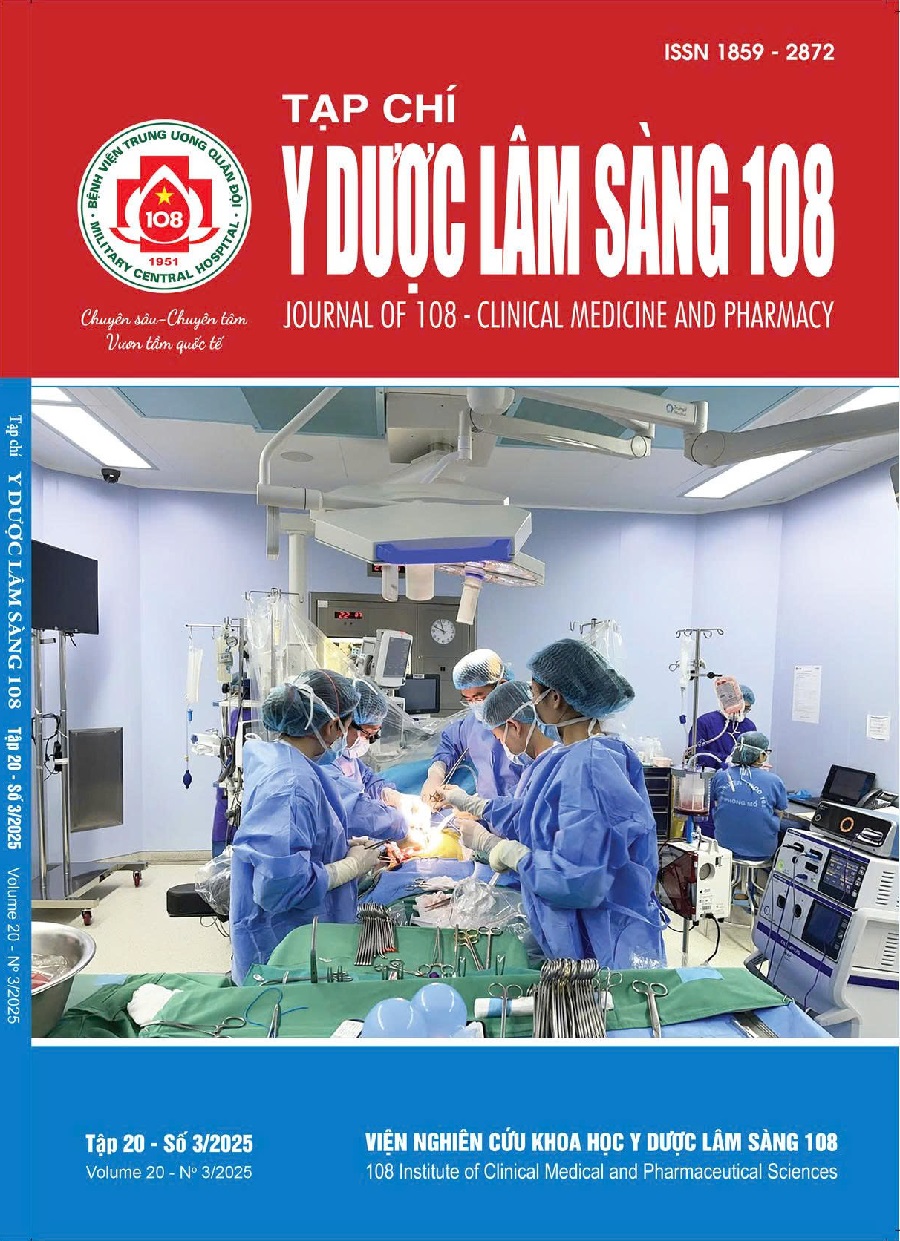Technical characteristics, diagnostic value of indocyanine green for de-tection lymph node and metastasis in laparoscopic gastrectomy with D2 lymphadenectomy for gastric cancer
Main Article Content
Keywords
Abstract
Objective: To evaluate the technical characteristics and diagnostic value of Indocyanine Green (ICG) for detecting lymph nodes and metastatic lymph nodes during laparoscopic gastrectomy with D2 lymphadenectomy in the treatment of gastric adenocarcinoma. Subject and method: A prospective descriptive study was conducted at the 108 Military Central Hospital from August 2021 to December 2024. Patients received submucosal ICG injection endoscopically one day prior to surgery. During surgery, a fluorescence imaging system was used to guide D2 lymphadenectomy. Result: A total of 81 patients were enrolled, with an average age of 61.7 ± 9.9 years and an average BMI of 22.13 ± 2.86kg/m². Preoperative staging primarily included cT2-3 (98.8%). The mean duration between ICG injection and surgery was 21.4 ± 2.9 hours. Technical success of ICG injection was achieved in 75.3% of cases, with minor complications including one case of subserosal hematoma, ICG diffusion over the gastric wall in 6 cases (7.4%), and diffuse staining around lymph nodes in 16 cases (19.8%). The average number of lymph nodes harvested per patient was 37.8 ± 11.8, of which fluorescent nodes averaged 30.2 ± 11.1. The node detection rate of ICG was 79.9%, notably with 90.9% of metastatic nodes showing fluorescence. Among non-fluorescent nodes, 97.1% were negative for metastasis. Conclusion: The technique of submucosal injection of ICG around the tumor one day before surgery can visualize the peritumoral lymphatic system, enhancing the efficiency of lymph node dissection during laparoscopic radical gastrectomy.
Article Details
References
2. Miyashiro I, Hiratsuka M, Sasako M, Sano T, Mizusawa J, Nakamura K et al (2014) High false-negative proportion of intraoperative histological examination as a serious problem for clinical application of sentinel node biopsy for early gastric cancer: final results of the Japan Clinical Oncology Group multicenter trial JCOG0302. Gastric Cancer 17(2): 316-323.
3. Kim TH, Kong SH, Park JH, Son YG, Huh YJ, Suh YS, et al (2018) Assessment of the Completeness of Lymph Node Dissection Using Near-infrared Imaging with Indocyanine Green in Laparoscopic Gastrectomy for Gastric Cancer. J Gastric Cancer 18(2): 161-171.
4. Chen QY, Zhong Q, Liu ZY, Li P, Lin GT, Zheng QL, et al (2023) Indocyanine green fluorescence imaging-guided versus conventional laparoscopic lymphadenectomy for gastric cancer: long-term outcomes of a phase 3 randomised clinical trial. Nature communications 14(1): 7413.
5. Jung MK, Cho M, Roh CK, Seo WJ, Choi S, Son T et al (2021) Assessment of diagnostic value of fluorescent lymphography-guided lymphadenectomy for gastric cancer. Gastric Cancer 24(2): 515-525.
6. Chen QY, Zhong Q, Li P, Xie JW, Liu ZY, Huang XB et al (2021) Comparison of submucosal and subserosal approaches toward optimized indocyanine green tracer-guided laparoscopic lymphadenectomy for patients with gastric cancer (FUGES-019): A randomized controlled trial. BMC medicine 19(1): 276.
7. Deng C, Zhang Z, Qi H, Guo Z, Liu Y, Xiao H et al (2022) Safety and efficacy of indocyanine green near-infrared fluorescent imaging-guided lymph nodes dissection during radical gastrectomy for gastric cancer: A systematic review and meta-analysis. Frontiers in oncology 12: 917541.
8. Van Du N, Tuan NA, Cuong LN (2025) Comparative study of ICG and non-ICG-guided laparoscopic gastrectomy for gastric cancer: a propensity score-matched analysis at a single center. BMJ Surgery, Interventions, & Health Technologies 7(1): 000313.
9. Chen QY, Xie JW, Zhong Q, Wang JB, Lin JX, Lu J et al (2020) Safety and Efficacy of Indocyanine Green Tracer-Guided Lymph Node Dissection During Laparoscopic Radical Gastrectomy in Patients With Gastric Cancer: A Randomized Clinical Trial. JAMA Surgery 155(4): 300-311.
10. Tonouchi H, Mohri Y, Tanaka K, Kobayashi M, Ohmori Y, Kusunoki M (2005) Laparoscopic Lymphatic Mapping and Sentinel Node Biopsies for Early-stage Gastric Cancer: The Cause of False Negativity. World Journal of Surgery 29(4): 418-421.
11. Su Z, Shu K, Zheng M, Sun X, Fang Z, Wang G (2013) Sentinel lymph node and skip metastases in gastric cancer: A prospective study. Hepatogastroenterology. 2013;60(126):1513-8.
12. Huang ZN, Qiu WW, Liu CH, Chen QY, Zheng C-H, Li P et al (2021) Assessment of indocyanine green tracer-guided lymphadenectomy in laparoscopic gastrectomy after neoadjuvant chemotherapy for locally advanced gastric cancer: Results from a multicenter analysis based on propensity matching. Gastric Cancer 24(6): 1355-1364.
13. Chen QY, Zhong Q, Li P et al (2021) Comparison of submucosal and subserosal approaches toward optimized indocyanine green tracer-guided laparoscopic lymphadenectomy for patients with gastric cancer (FUGES-019): a randomized controlled trial. BMC medicine 19(1): 276.
 ISSN: 1859 - 2872
ISSN: 1859 - 2872
